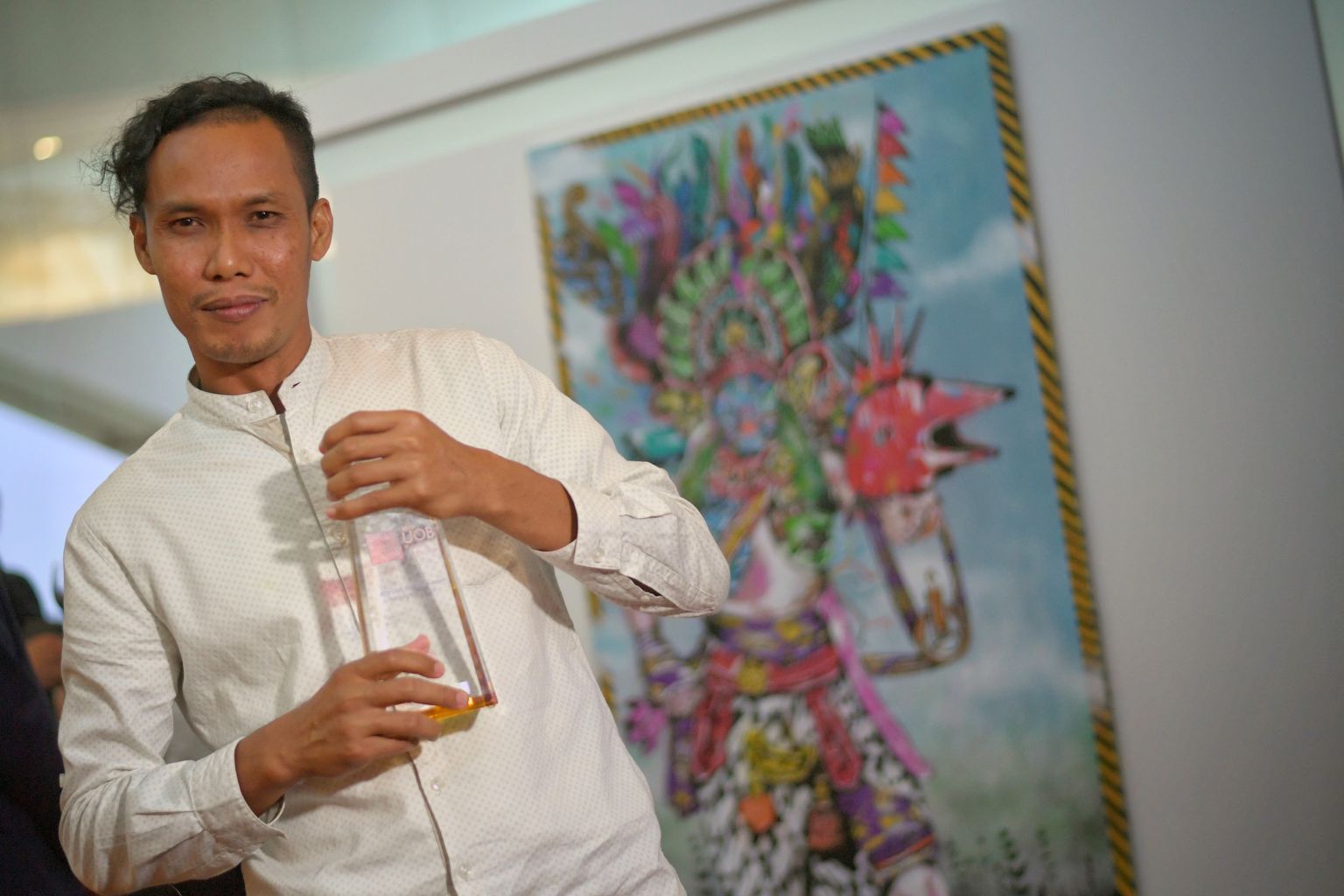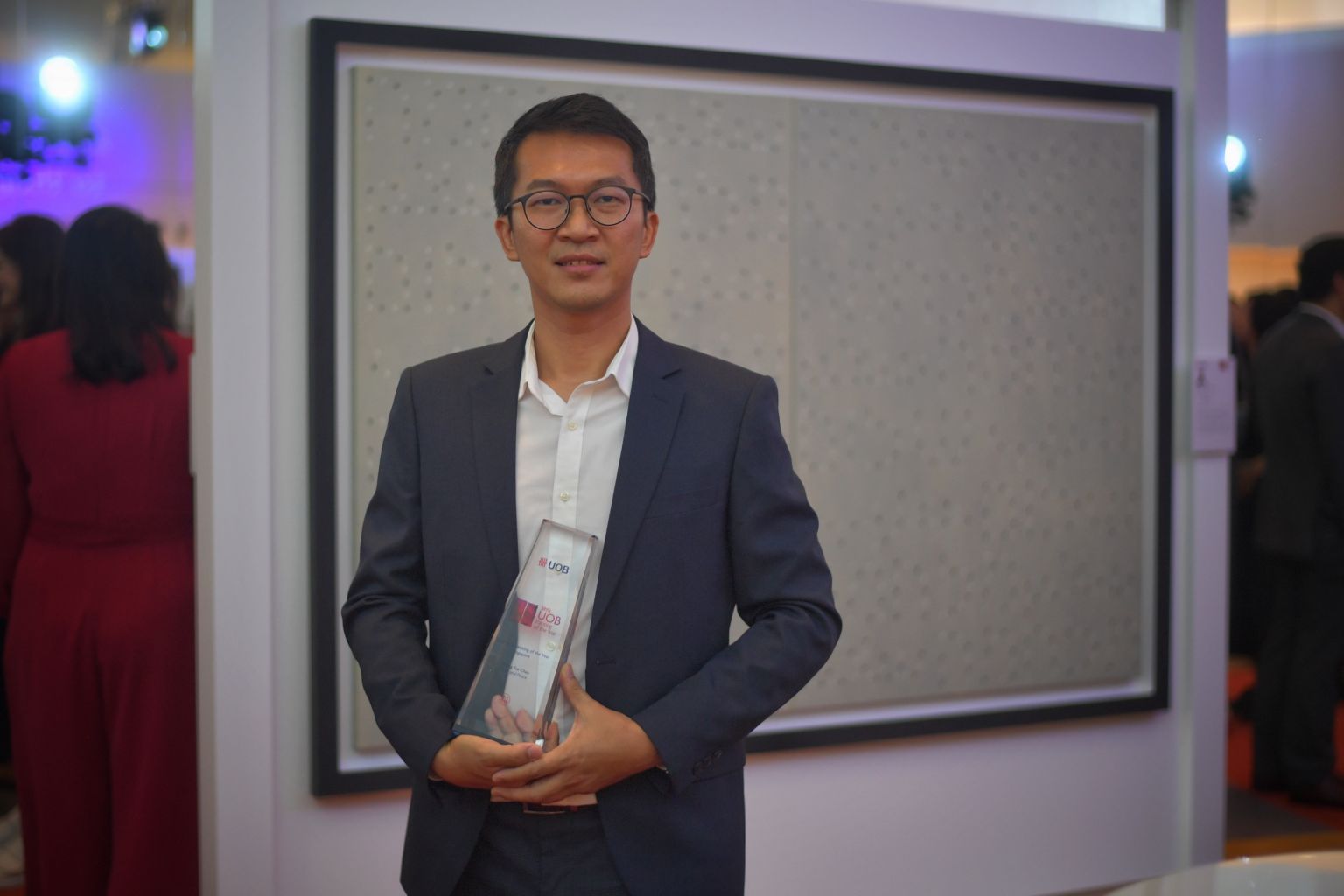UOB South-east Asian Painting of the Year winner, Indonesia's Anagard, wants to give back to the community
Sign up now: Get ST's newsletters delivered to your inbox

Artist Anagard with his work titled Welcome Perdamaian, Goodbye Kedengkian (Welcome Peace, Goodbye Hostility). He studied at the Indonesian Institute of the Arts in Yogyakarta.
ST PHOTO: ARIFFIN JAMAR
Follow topic:
SINGAPORE - Take a jaunt down the streets of Yogyakarta, Chiang Mai or Berlin and you might spot colourful hybrids of humans and animals spray-painted on the neighbourhood walls. These curious figures, often painted in deep rainbow colours with messages of diversity, love and anti-fascism, are the creations of Anagard - a 35-year-old Indonesian street artist who also happens to be an award-winning painter.
Last Wednesday (Nov 6), he won the UOB South-east Asian Painting of the Year award for Welcome Perdamaian, Goodbye Kedengkian (Welcome Peace, Goodbye Hostility), a stencil spray paint on aluminium work inspired by a house of prayer in Central Java. This famous Rhema Hill house of prayer, known to locals as the "chicken church", is a place of prayer for people of all religions.
The winning painting, which explores the idea of harmony amid diversity, features a cat-faced human figure wearing a fanciful, feathery headdress, and is fringed with alternating black and yellow stripes, the sort you see on hazard tape.
Anagard laments the rise of extremism in his country. In 2017, Jakarta's governor, Mr Basuki Tjahaja Purnama, an ethnic-Chinese Christian who is popularly known as Ahok, was sentenced to two years' jail for blasphemy. The artist adds that Yogyakarta - the arts hub where he lives - has also grown increasingly intolerant.
"They say Jogja is a city of tolerance, but since 2016, it's hard to say if Jogja is tolerant any more."
Anagard, born to the owners of a small restaurant in Padang, West Sumatra, is the fourth of eight children. He studied at the Indonesian Institute of the Arts (ISI) in Yogyakarta before working as an artist.
He made his first forays into street art about a decade ago.
"When I make art on a canvas, I say my work is about social issues - yet I make these paintings in my studio, send them to galleries for exhibitions, and only people in the galleries can see my work. Street art is the best way of proving that you support your local society."
"When I make street art, I feel alive," adds the artist, who draws and cuts out his stencils by hand, and has been invited to street art festivals in Lithuania and Poland.
The moniker Anagard (inspired by an ex-girlfriend's name) helps him stay safe: Some people see him as a vandal, while others are offended by the messages in his work.
"I don't make street art to be famous. If people know my real identity, it's dangerous. Maybe one day I'll lose one hand. Who knows?"
These days, he often gets permission from building owners before painting, which he says also makes the work less likely to be removed.
He is no stranger to having his art effaced. In 2012, he joined a protest against the education ministry's decision to convert Yogyakarta's ISI into the Indonesian Institute of Arts and Culture. The mural he spray-painted on the institute's walls was removed.
United Overseas Bank's (UOB) Painting of the Year award, now in its 38th year, is the longest-running art contest in Singapore.
The UOB South-east Asian Painting of the Year award was introduced in 2013 and is given to the most outstanding of the national winners from Singapore, Malaysia, Thailand and Indonesia. Anagard received US$10,000 (S$13,600)- on top of the 250 million rupiah (S$24,240) he won for the UOB Painting of the Year (Indonesia) award.
He plans to travel, send his mother on a pilgrimage to Mecca, make some donations to charity and channel some of the prize money into the arts community - for instance by opening a gallery.

Artist Wong Tze Chau with his artwork tittled, War and Peace.
ST PHOTO: ARIFFIN JAMAR
Meanwhile, the UOB Painting of the Year (Singapore) award was won by part-time polytechnic lecturer Wong Tze Chau for his acrylic on cotton canvas diptych War And Peace. He received a US$25,000 cash prize.
The seemingly placid painting, dotted with the Hebrew and Arabic words for "war" and "peace", alludes to the long-running conflict Israeli-Palestinian conflict.
"Every living being in the world is interconnected," says 41-year-old Wong, who has bachelor degrees in architecture and philosophy, and a master's in education (visual arts). "I wanted to give people the illusion that (the two sides of the dipytch) might be mirror images, or that one side is war, and another is peace - when that's actually not the case."
"This is my third attempt taking part in the UOB competition. Finally, I've won something."
The winning works will be displayed at UOB Art Gallery in UOB Plaza 1, 80 Raffles Place till Feb 20. www.uobpoy.com/artgallery

